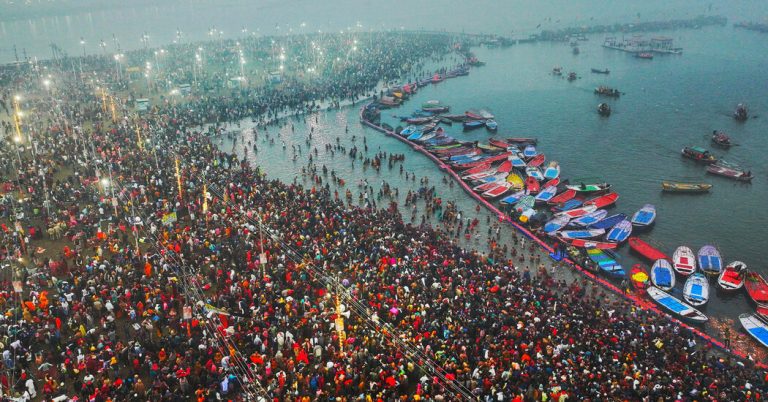Tens of millions of Hindus are gathering this week in the world’s largest human gathering, where a staggering number of worshippers, tourists, politicians and celebrities take holy dips at the confluence of two holy rivers in India.
The religious festival, called the Maha Kumbh Mela, happens every 12 years on the banks of the Ganges and Yamuna rivers in the northern Indian city of Prayagraj. Officials this year expect up to 400 million people – more than the population of the United States – to visit the site in Uttar Pradesh state over the next six weeks.
An important display of Hinduism, the event has recently become a major political event with the rise of Hindu nationalism, supported by Prime Minister Narendra Modi’s right-wing political party. It’s also a huge logistical undertaking for government officials working to prevent incidents such as bug bites and the spread of disease.
What is the Maha Kumbh Mela?
The Maha Kumbh Mela, or “great festival of the sacred pitcher”, is the largest religious ceremony in the world. Based on a Hindu myth in which demons and gods fight over a pitcher that carries the nectar of immortality, the centuries-old ceremony centers around a series of sacred baths, which Hindus say cleanse their sins.
The holy baths are preceded by processions involving singing and dancing people in vibrant costume, on elaborately decorated chariots and carrying ceremonial spears, tridents and swords. To participate, people travel from all over India and the world to the confluence of the Ganges and Yamuna rivers, a sacred site also said to be the terminus of a mythical third river, the Saraswati.
The timing of the festival, which this year ends on February 26, is based on the astrological alignment of the sun, the moon and the planet Jupiter, which takes about 12 years to revolve around the sun. Smaller versions of the festival are held in one of three other Indian cities – Haridwar, Nashik and Ujjain – about every three years.
How big is the festival?
The scale of the Maha Kumbh Mela is astounding. The latter, in 2013, attracted 120 million people to Prayagraj, according to a government estimate. An intermediate festival in 2019, although less important religiously, attracted 240 million people.
This year, the city, home to about 6 million residents, is preparing to host 300 to 400 million people, government officials said. In preparation, the state has built a temporary campground on a 10,000-acre site, with tens of thousands of tents and bathrooms, roads, parking lots, water and electricity infrastructure, and thousands of security cameras and drones.
Many of these preparations – likely to make it the most expensive Maha Kumbh Mela to date, at around $800 million – are intended to prevent deadly riots and disease outbreaks, which have occurred at previous festivals. The event is also expected to generate billions of dollars in revenue for the state government, officials said.
To accommodate bathers, the government has also installed a platform of sandbags along a seven-mile stretch of the Ganga river bank. On Monday and Tuesday, millions of pilgrims poured down the river to those steps in the freezing morning mist, praying for happiness, health and prosperity.
What is the significance of the festival today?
The Maha Kumbh Mela has always been an important symbol of Hinduism, although it was usually not politicized until the recent rise of the idea of India as a Hindu nation. This year’s festival is the first since the Hindu nationalist political party of Mr. Modi’s BJP became the country’s ruling party 11 years ago.
“It would be interesting to see if Prime Minister Modi goes,” said Arati Jerath, a political analyst in New Delhi. “It is supposed to be the greatest and most auspicious time to take a dip in the Ganges.”
Yogi Adityanath, the chief minister of Uttar Pradesh, who is also a hardline Hindu priest, changed the name of the festival’s host city in 2018 to Prayagraj from Allahabad. The move, part of a wave of changes brought about by the BJP, replaced the Muslim name given by the 16th-century Mughal emperor Akbar with one referring to the Hindu pilgrimage site.
In 2019, when India held general elections, the Kumbh Mela presented an important political opportunity to Mr. Modi and his party to address a receptive audience of millions. Mr. Modi won this election.
The next general election is further away this time, scheduled for 2029. But Mr. Modi, who won by a narrow margin while his party suffered defeats in last year’s election, has placed himself on posters advertising the festival nationwide and called it an embodiment of India’s “timeless spiritual heritage” on social media, linking the spiritual event with the national identity of the country.
“The BJP hopes to use it to consolidate its Hindu nationalist base,” Ms. Jerath. But he added that it was unclear whether that would necessarily win the party more votes. “Whether it works or not, I don’t know, but it certainly helps take the BJP a step closer to its goal of turning India into a Hindu majority nation.”




